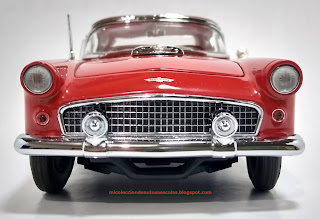Este es un blog de fotografías para la colección personal de autos de diferentes escalas.
Sunday, June 12, 2016
1925 Ford Model T Runabout (broken) 1:24 Danbury Mint.
Tuesday, March 1, 2016
1928 Stutz Black Hawk Boattail Speedster Danbury Mint 1:24
At the New York National Auto Show in 1926, spectators bent over to see why the car was so low. Its pedigree dictated that this new Stutz be sent racing, and this was done in 1927 with the Black Hawk Speedster, set on the shorter of the Series BB chassis and a whopping 1,377 pounds less weighty than the Stutz sedan. Five victories in two weeks were the immediate result – and the AAA National Stock Championship.
Black Hawk victories during Daytona’s Speedweek the following January numbered three, among them a 106.25 mph run that made Stutz America’s fastest production car. Moskovics was unimpressed. Records should be made in races, he sniffed, peeved that the Contest Board was putting its imprimatur on private board track records made by Auburn.
Besides, Moskovics had a race of his own to occupy his time: the celebrated 24-hour contest that pitted the Black Hawk against Charles Weymann’s Hispano-Suiza, and which Stutz would lose. Nothing had ever broken on a Black Hawk in a race before. A valve keeper did that day; the valve dropped and broke the connecting rod. For Le Mans in June, however, that same Charles Weymann entered a Black Hawk to challenge the “Bentley boys,” who regarded that race as their private preserve. What a fight it was – the lone Stutz battled the three cars of the Bentley team with ferocity, dogged two of them into retirement, and finished second behind the third.
Two decades after it was built, the display car, driven by Dud C. Wilson, raced at Watkins Glen in 1948.
Saturday, April 28, 2012
1935 Duesenberg SSJ 1:24 Danbury Mint
El Duesenberg J fue uno de los automóviles más exclusivos que se construyeron no sólo en los Estados Unidos, sino en el mundo entero. El Duesenberg J (en sus diversas versiones) representó el poder y la opulencia característicos de las épocas de bonanza de la Norteamérica de los 1920, soportando la Gran Depresión gracias a los multimillonarios y actores de Hollywood, sus principales compradores. Entre los más notables usuarios estaban Clark Gable y Gary Cooper personajes que elevaron al J como un auto legendario.
Este automóvil superó la crisis económica al lograr que su reducida producción se extendiera hasta 1937, nueve años después de su lanzamiento, sin que su coste de 20 000 USD, alto para la época, fuera un impedimento. Con un motor de 6,9 litros y 198 kW (269 cv) a 4200 rpm, era capaz de alcanzar hasta los 200 km/h. 378 de los 481 Duesenberg J construidos todavía existen, siendo uno de los coches más buscados y valiosos para los coleccionistas, que son capaces de ofrecer extraordinarias cantidades por tener una de estas obras de arte.
Alfonso XIII usó un vehículo de este modelo para desplazarse de Madrid a Cartagena, la noche del 14 al 15 de abril de 1931, cuando salía al exilio.Saturday, January 28, 2012
1956 Ford Thunderbird 1:24 Danbury Mint
The first generation of the Ford Thunderbird is a two-seat convertible produced by Ford for the 1955 to 1957 model year, the first 2-seat Ford since 1938. It was developed in response to the 1953 Motorama display at the New York Auto Show, which showed the Chevrolet Corvette. The Corvette in turn was developed in response to the popularity of European sports cars among Americans.
Dubbed a "a personal car of distinction" by Ford, this appellation was also used by the motoring press at the time. The car built upon the heritage of the bespoke roadsters of the 1930s, yet was constructed largely of existing components, marking the first step toward the evolution of the personal luxury car as a mass market segment in the United States. While light weight for its era and fitted with a standard V8 engine, the Thunderbird focused more on driver comfort than speed, and was not a direct rival to either the Corvette or European sports cars. The Thunderbird proved more suited to the American market than the Corvette, with sales of 16,155, versus 674 Corvettes in 1955. This remained the only two-seat convertible Thunderbird until the eleventh-generation was unveiled in 2002.








































